 Hartlepool Sports & Leisure
Hartlepool Sports & Leisure
- Cinemas, Theatres & Dance Halls
- Musicians & Bands
- At the Seaside
- Parks & Gardens
- Caravans & Camping
- Sport
 Hartlepool Transport
Hartlepool Transport
- Airfields & Aircraft
- Railways
- Buses & Commercial Vehicles
- Cars & Motorbikes
- The Ferry
- Horse drawn vehicles
 A Potted History Of Hartlepool
A Potted History Of Hartlepool
- Unidentified images
- Sources of information
- Archaeology & Ancient History
- Local Government
- Printed Notices & Papers
- Aerial Photographs
- Events, Visitors & VIPs
 Hartlepool Trade & Industry
Hartlepool Trade & Industry
- Trade Fairs
- Local businesses
- Iron & Steel
- Shops & Shopping
- Fishing industry
- Farming & Rural Landscape
- Pubs, Clubs & Hotels
 Hartlepool Health & Education
Hartlepool Health & Education
- Schools & Colleges
- Hospitals & Workhouses
- Public Health & Utilities
- Ambulance Service
- Police Services
- Fire Services
 Hartlepool People
Hartlepool People
 Hartlepool Places
Hartlepool Places
 Hartlepool at War
Hartlepool at War
 Hartlepool Ships & Shipping
Hartlepool Ships & Shipping

Brougham School
Details about Brougham School
The original school opened in 1896 and was closed in 1985 when the new building opened nearby. The original building is now used as an enterprise centre.
Location
Related items :
 Aerial photo circa 1945 Dyke House and Brougham Schools
Aerial photo circa 1945 Dyke House and Brougham Schools
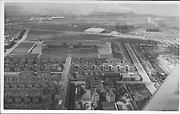 Donated by Hartlepool Library Service
Donated by Hartlepool Library ServicePart of the Hartlepool Library Collection collection
Dated 1945
Photo will probably have been taken when Dyke House School was opened in 1945 having been built just before WW2. The road in the middle leading up to Dyke House School is Mapleton Road (then called Hart Street being changed in 1967 because of another Hart Street on the Headland) The school in the foreground is the original Brougham which is now an enterprise centre.
The road on the right is Milbank Road which at the time did not reach Powlett Road. The new factory in Powlett Road is Prices Tailors, the first factory opened on the trading estate in 1945. The roundabout where Easington, Raby and Powlett Roads and Winterbottom Ave meet had not been constructed and would later be in the top left.
More detail » Brougham School
Brougham School
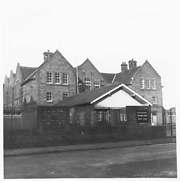 Donated by Douglas Ferriday
Donated by Douglas FerridayPart of the Hartlepool Library Service collection
Dated 1973
Brougham School, in Brougham Terrace, taken in 1973.
More detail » Brougham School - Division B Football Champions 1963-64
Brougham School - Division B Football Champions 1963-64
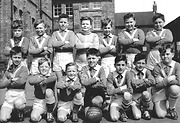 Donated by Brougham School - Division B Football Champions 1963-64
Donated by Brougham School - Division B Football Champions 1963-64Dated 1964
Brougham School Boys Division B Football Champions 1963-64.
More detail » Brougham School Football and Cricket champions 1909
Brougham School Football and Cricket champions 1909
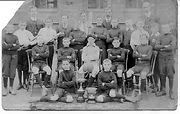 Donated by Mr. Keith Bloomfield
Donated by Mr. Keith BloomfieldDated 1909
Brougham School Football and Cricket champions around 1909-10.
More detail » Brougham School Infants Group 6
Brougham School Infants Group 6
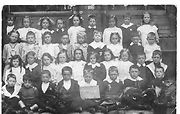 Donated by Mr. Keith Bloomfield
Donated by Mr. Keith BloomfieldDated 1909
 Brougham School number 12
Brougham School number 12
 Created by Kipling Stockton on Tees
Part of the Hartlepool Museum Service collection
Created by Kipling Stockton on Tees
Part of the Hartlepool Museum Service collectionAt first glance, a class of boys who look fairly smart, but on closer inspection there seems to be a large age range within the group and some are poorly dressed . In terestingly on the front row is a boy who appears to be of mixed race which must have been rare at the time in a Hartlepool school.
The image will probably be from around 1900 when the school was quite new.
More detail » Brougham School team- 1930s
Brougham School team- 1930s
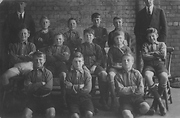 Donated by Mr. John Watson
Donated by Mr. John WatsonA boy's football(?) team, possibly from Brougham School in the 1930s.
More detail » Brougham Sports Day at Grayfields
Brougham Sports Day at Grayfields
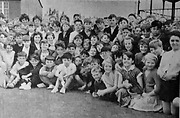 Created by NDM
Donated by Hartlepool Museum Service
Created by NDM
Donated by Hartlepool Museum ServiceDated 1961
Taken in June 1961 the photo shows Brougham children at their sports day. The competing houses were Aidan! Bede, Columba and Oswald.
More detail » Brougham old and new
Brougham old and new
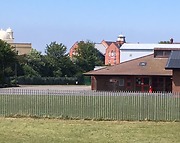 Created by F.Wilson
Dated 2017
Created by F.Wilson
Dated 2017Taken from Middleton Road, the image shows the 1985 built Brougham School and to the left of it is the original School which is now Broaugham Enterprise Centre. To the left of that is Hartlepool Mosque.
More detail » Brougham schoolboys
Brougham schoolboys
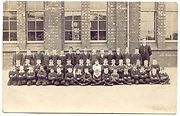 Donated by Mr. Keith Bloomfield
Donated by Mr. Keith BloomfieldDated 1904
A group photographs of the boys at Brougham School in 1904/05. James Arthur Bloomfield is 6th from the right on the back row.
More detail » Class 1 Brougham Infants - 1949
Class 1 Brougham Infants - 1949
 Donated by Joe Green
Donated by Joe GreenDated 1949
Class 1, Brougham Infants, 1949. The only names known so far are: John Green (Row 3, 5th from left); Irving James (Row 4, far left); Alan Dring (Row 4, 2nd from left); - Nunn (Row 4, 4th from left); Anne Kerr (Row 4, 7th from left).
More detail » Class 7 Brougham Junior School - 1951
Class 7 Brougham Junior School - 1951
 Donated by Joe Green
Donated by Joe GreenDated 1951
Class 7 of Brougham Junior Mixed School, 1951.
More detail » Early Wartime Memories by David Willis
Early Wartime Memories by David Willis
David Willis no longer lives in the town but has kindly sent in his reminiscences of a Wartime childhood in Hartlepool.
In the late 1930s I remember the visit of the 'chocolate train', which was parked up in a dead end platform at the east end of West Hartlepool Station. The whole train was decked out in colours which from memory resembled the Cadbury colours. I made several visits as samples of various chocolates were on display and were given away to hungry kids like me. I wonder if anyone else remembers the 'chocolate train', which left many very sad small people as it finally pulled out of the station.
The other major event was the spectacular burning down of Dyke House Farm and its surrounding buildings, which I think must have been organised by the Fire Brigade, as I distinctly remember Firemen silhouetted against the flames as the fire took hold. There was also an accompanying firework display. It seemed to me that most of the town must be in attendance as we looked on from Wharton Terrace. This was prior to the house-building on the site and also that of Dyke House School, which never got beyond the foundation stage before the onset of the War, but provided a magnificent playground for children.
With regard to St Oswald Street itself, it had its own garrison of troops, stationed in a building at the Raby Road end of the street. The building was Waugh's Bakery and the soldiers were from a Scottish regiment resplendent in their kilts. Each evening a lone piper would march up and down the street. The soldiers used a large sliding door in Wharton Terrace backlane to access the building and a well-known tramp could often be seen near this door looking for scraps of food. One day the soldiers put him in a barrel of water and scrubbed him clean. Waugh's also had a cake and bread shop immediately opposite the bakery. In addition there was a further shop at the other end of the street, known as McGhees general store.
Prewar the United Bus Company had a garage on Raby Road immediately opposite St Oswald's Street which was taken over as a Fire Station for the duration, housing several large engines.
In the early years of the War, Brougham School was taken over by the army. Many of the pupils spent the next 3 or 4 years getting a part-time education in houses. For example, a group of pupils from the St Oswald Street/Chester Road area met for about three half-days a week in my parent's house (12 St Oswald's Street), next door at number 10, or at a house at the Raby Road end of Chester Road.
When Dyke House opened we resumed full time education there and I can remember growing vegetables in the quadrangles in the 'Dig for Victory' campaign. I was there for 1 or 2 years and my teacher was Miss Salt. I took the 11 plus at Dyke House before moving on to West Hartlepool Grammar School in September 1945.
Just postwar I joined the youth club run by Westbourne Church between Stranton and the Burn Valley. We had a very successful football team, playing as far afield as Darlington and Sunderland. We were known as the Guild of Youth, a future well known team member being Brian London who fought Mohammed Ali for the World Heavyweight title. I was at the Grammar School at the time, a bastion of rugby, where the Headmaster insisted on boys playing rugby in winter if they wished to play cricket in summer, which I loved. This led to all sorts of rushing journeys between morning rugby matches and afternoon soccer games, especially if these were 20 miles apart.
More detail »



